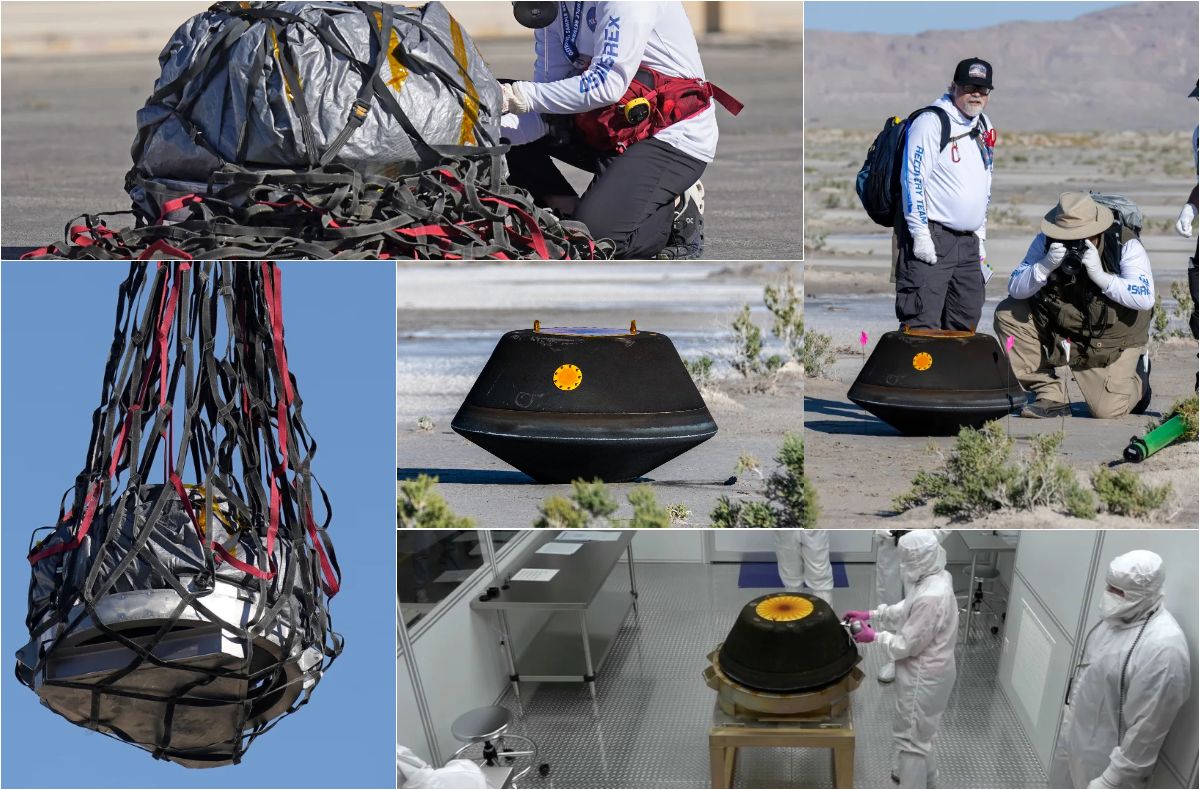NASA’s OSIRIS-REx spacecraft successfully landed a capsule containing asteroid Bennu samples in the Utah desert on Sunday, September 24, 2023. The capsule landed at 10:52 a.m. EDT, about 10 minutes after entering the atmosphere. The samples were collected in October 2020 and are the largest asteroid samples ever received on Earth.
The OSIRIS-REx mission launched in 2016 and arrived at Bennu in 2018. The mission’s full name is Origins, Spectral Interpretation, Resource Identification, Security-Regolith Explorer. The capsule landed on the Department of Defense’s Utah Test and Training Range, about 70 miles west of Salt Lake City.
The spacecraft dropped the sample capsule — containing an estimated 8.8 ounces of asteroid rocks and soil — from a distance of 63,000 miles (102,000 kilometers) above Earth’s surface early Sunday, and entered the planet’s atmosphere at 10:42 a.m. ET while traveling at a speed of about 27,650 miles per hour (44,498 kilometers per hour).
Parachutes deployed to slow the capsule to a gentle touchdown at 11 miles per hour (17.7 kilometers per hour). The sample landed in the Defense Department’s Utah Test and Training Range about 10 minutes after entering the atmosphere, a few minutes ahead of schedule.
“Congratulations to the OSIRIS-REx team. You did it,” said NASA administrator Bill Nelson. “It brought something extraordinary, the largest asteroid sample ever received on Earth. This mission proves that NASA does big things, things that inspire us, things that unite us. It wasn’t mission impossible. It was the impossible that became possible.”
OSIRIS-REx is continuing its tour of the solar system — the spacecraft has already set off to capture a detailed look at a different asteroid named Apophis.
The mission now has a new name: OSIRIS-APEX, for Origins, Spectral Interpretation, Resource Identification, Security-APophis EXplorer.
Four helicopters transported recovery and research teams to the landing site and conducted assessments to make sure the capsule wasn’t damaged in any way, said Rich Burns, OSIRIS-REx project manager at NASA’s Goddard Space Flight Center in Greenbelt, Maryland. The team confirmed that the capsule was not breached during landing.
Recovery teams, which have been training for the event for months, retrieved the capsule once it was safe, said Sandra Freund, OSIRIS-REx program manager at Lockheed Martin Space, which partnered with NASA to build the spacecraft, provide flight operations and help recover the 100-pound capsule.
The initial recovery team, outfitted with protective gloves and masks, ensured that the capsule was cool enough to touch, given that it reached temperatures up to 5,000 degrees Fahrenheit (2,760 degrees Celsius) during reentry, Burns said. The team also ensured the capsule’s battery didn’t rupture and leak any toxic fumes.
A science team collected samples from the landing site, including air, dust and dirt particles.
“One of the key scientific objectives of OSIRIS-REx is to return a pristine sample and pristine means that no foreign materials hamper our investigation during sample analysis,” said Dante Lauretta, OSIRIS-REx principal investigator at the University of Arizona in Tucson. “As unlikely as it is, we do want to make sure any materials that are out there in the Utah range that may interact with the sample are well documented.”
Lauretta has worked on the mission for nearly twenty years and remembers when it was part of an idea presented to NASA. Lauretta has been present for each step of the way, including when the capsule was assembled and installed on the spacecraft before launch. And on Sunday, he was one of the first people to approach the capsule after it landed to welcome it home.
“It was like seeing an old friend that you hadn’t seen for a long time,” he said. “I did want to give it a hug. One of the key moments for me was seeing it. I knew we had done it, that we had pulled it off. As incredible as it seemed all those years ago, it came to be.”
A helicopter carried the sample in a cargo net and delivered it to a temporary clean room near the landing site. Within this space, the curation team will conduct a nitrogen flow, called a purge, to prevent any of Earth’s atmosphere from entering the sample canister and contaminating it. The larger pieces of the capsule will be stripped away, said Nicole Lunning, OSIRIS-REx curation lead at NASA’s Johnson Space Center in Houston.
A team will prepare the sample canister for transport on a C-17 aircraft to NASA’s Johnson Space Center in Houston on Monday. Scientists expect to remove the lid to see the sample for the first time on Tuesday.
The recovery team will also assess all of the footage captured of the descent to determine if the drogue parachute, used to initially stabilize the capsule, deployed on time. At the time it was expected to release, the team was unable to see visual evidence. The main parachute, responsible for slowing down the capsule to a safe landing speed, also deployed early.
“But at the end of the day, when that main chute deployed, it basically corrected any of the sins that may have happened ahead of it,” said Tim Priser, chief engineer for deep space exploration at Lockheed Martin. “It touched down like a feather.”
It’s crucial to understand more about the population of near-Earth asteroids that may be on an eventual collision course with our planet. A better grasp of their composition and orbits is key to predicting which asteroids may have the closest approaches to Earth and when — and essential to developing methods of deflecting these asteroids based on their composition.

